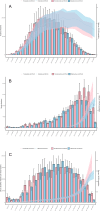Global, regional, and national burden of inflammatory bowel disease, 1990-2021: Insights from the global burden of disease 2021
- PMID: 39243331
- PMCID: PMC11380638
- DOI: 10.1007/s00384-024-04711-x
Global, regional, and national burden of inflammatory bowel disease, 1990-2021: Insights from the global burden of disease 2021
Abstract
Purpose: The prevalence of inflammatory bowel disease (IBD) is on the rise worldwide. We utilizes data from the Global Burden of Diseases (GBD) 2021 to analyze the national-level burden of IBD, trends in disease incidence, and epidemiological characteristics.
Methods: Detailed information on IBD was gathered from 204 countries and territories spanning 1990 to 2021, sourced from the GBD 2021. Calculations were performed for incidence rates, mortality rates, disease-adjusted life years (DALYs), and estimated annual percentage changes (EAPCs). These trends were analyzed based on region, nationality, age, gender, and World Bank income level stratifications.
Results: The global age-standardised incident rate (ASIR) of IBD increased from 4.22 per 100000 in 1990 to 4.45 per 100000 in 2021. However, the age-standardised mortality rate (ASMR) decreased from 0.60 per 100000 in 1990 to 0.52 per 100000 in 2021. Similarly, the age-standardised DALYs rate decreased from 21.55 per 100000 in 1990 to 18.07 per 100000 in 2021. Gender comparisons showed negligible differences in disease burden. The greatest increase in IBD-associated ASIR and ASMR occurred in World Bank upper-middle income region (EAPCs, 1.25) and World Bank high-income region (EAPCs, 1.00), respectively. Regionally, East Asia experienced the largest increase in ASIR (EAPCs, 2.89). Among 204 countries, China had the greatest increases in ASIR (EAPCs, 2.93), Netherlands had the highest ASMR in 2021 (2.21 per 100000).
Conclusions: Global incidence rate of IBD have been increasing from 1990 to 2021, while the DALYs and mortality have been decreasing. The escalating incident rates in select Asian regions deserves further attention.
Keywords: Epidemiology; Global Burden of Diseases; Inflammatory bowel disease.
© 2024. The Author(s).
Conflict of interest statement
The authors declare no competing interests.
Figures


Similar articles
-
Global, regional and national burden of inflammatory bowel disease in 204 countries and territories from 1990 to 2019: a systematic analysis based on the Global Burden of Disease Study 2019.BMJ Open. 2023 Mar 28;13(3):e065186. doi: 10.1136/bmjopen-2022-065186. BMJ Open. 2023. PMID: 36977543 Free PMC article. Review.
-
Burden of Stomach Cancer Incidence, Mortality, Disability-Adjusted Life Years, and Risk Factors in 204 Countries, 1990-2019: An Examination of Global Burden of Disease 2019.J Gastrointest Cancer. 2024 Jun;55(2):787-799. doi: 10.1007/s12029-023-01005-3. Epub 2024 Jan 24. J Gastrointest Cancer. 2024. PMID: 38265570
-
Epidemiological analysis reveals a surge in inflammatory bowel disease among children and adolescents: A global, regional, and national perspective from 1990 to 2019 - insights from the China study.J Glob Health. 2023 Dec 1;13:04174. doi: 10.7189/jogh.13.04174. J Glob Health. 2023. PMID: 38037705 Free PMC article.
-
Disparities in the global burden of tracheal, bronchus, and lung cancer from 1990 to 2019.Chin Med J Pulm Crit Care Med. 2023 Mar 28;1(1):36-45. doi: 10.1016/j.pccm.2023.02.001. eCollection 2023 Mar. Chin Med J Pulm Crit Care Med. 2023. PMID: 39170872 Free PMC article.
-
Analysis of global prevalence, DALY and trends of inflammatory bowel disease and their correlations with sociodemographic index: Data from 1990 to 2019.Autoimmun Rev. 2024 Oct 2;23(11):103655. doi: 10.1016/j.autrev.2024.103655. Online ahead of print. Autoimmun Rev. 2024. PMID: 39366514 Review.
References
-
- GBD 2017 Inflammatory Bowel Disease Collaborators (2020) The global, regional, and national burden of inflammatory bowel disease in 195 countries and territories, 1990–2017: a systematic analysis for the Global Burden of Disease Study 2017. Lancet Gastroenterol Hepatol 5(1):17–30 10.1016/S2468-1253(19)30333-4 - DOI - PMC - PubMed
MeSH terms
Grants and funding
LinkOut - more resources
Full Text Sources

